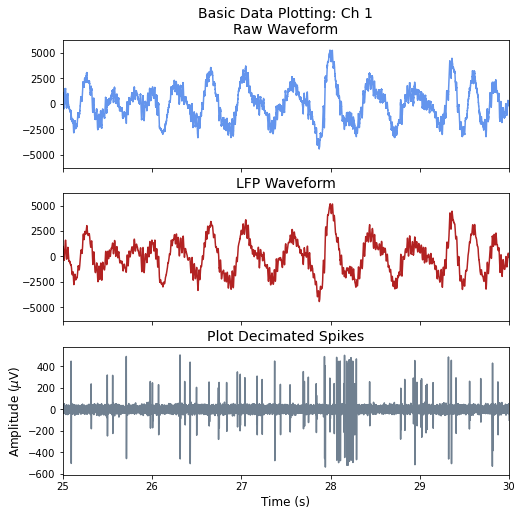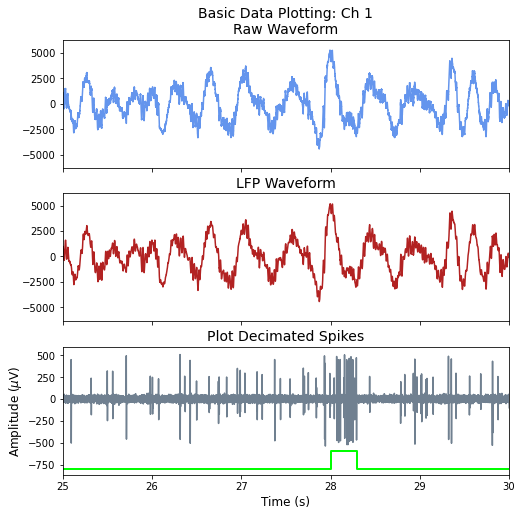Stream Plot Example
Import Continuous Data into Python
Plot a single channel of data with various filtering schemes
Good for first-pass visualization of streamed data
Combine streaming data and epocs in one plot
Housekeeping
Import the tdt package and other python packages we care about.
# special call that tells notebook to show matlplotlib figures inline
%matplotlib inline
import matplotlib.pyplot as plt # standard Python plotting library
import numpy as np # fundamental package for scientific computing, handles arrays and math
# import the tdt library
import tdt
Importing the Data
This example uses our example data sets. To import your own data, replace BLOCK_PATH with the full path to your own data block.
In Synapse, you can find the block path in the database. Go to Menu → History. Find your block, then Right-Click → Copy path to clipboard.
tdt.download_demo_data()
BLOCK_PATH = 'data/Algernon-180308-130351'
demo data ready
Now read channel 1 from all stream data into a Python structure called 'data'
data = tdt.read_block(BLOCK_PATH, evtype=['streams', 'epocs'], channel=1)
read from t=0s to t=61.23s
And that's it! Your data is now in Python. The rest of the code is a simple plotting example.
Stream Store Plotting
Let's create time vectors for each stream store for plotting in time.
time_Wav1 = np.linspace(1, len(data.streams.Wav1.data), len(data.streams.Wav1.data)) / data.streams.Wav1.fs
time_LFP1 = np.linspace(1, len(data.streams.LFP1.data), len(data.streams.LFP1.data)) / data.streams.LFP1.fs
time_pNe1 = np.linspace(1, len(data.streams.pNe1.data), len(data.streams.pNe1.data)) / data.streams.pNe1.fs
Plot five seconds of data from each store
fig, (ax1, ax2, ax3) = plt.subplots(nrows=3, ncols=1, figsize=(8, 8), sharex=True)
ax1.plot(time_Wav1, data.streams.Wav1.data*1e6, color='cornflowerblue')
ax1.set_title('Basic Data Plotting: Ch 1\nRaw Waveform', fontsize=14)
ax2.plot(time_LFP1, data.streams.LFP1.data*1e6, color='firebrick')
ax2.set_title('LFP Waveform', fontsize=14)
ax3.plot(time_pNe1, data.streams.pNe1.data, color='slategray')
ax3.set_title('Plot Decimated Spikes', fontsize=14)
ax3.set_xlabel('Time (s)', fontsize=12)
ax3.set_ylabel('Amplitude ($\mu$V)', fontsize=12)
ax1.set_xlim(25, 30)
plt.show()

Epoc Events
Generate continuous time series for epoc data using epoc timestamps
# StimSync epoc event
STIM_SYNC = 'PC0_'
pc0_on = data.epocs[STIM_SYNC].onset
pc0_off = data.epocs[STIM_SYNC].offset
pc0_x = np.reshape(np.kron([pc0_on, pc0_off], np.array([[1], [1]])).T, [1, -1])[0]
Make a time series waveform of epoc values and plot them.
sz = len(pc0_on)
d = data.epocs[STIM_SYNC].data
pc0_y = np.reshape(np.vstack([np.zeros(sz), d, d, np.zeros(sz)]).T, [1,-1])[0]
ax3.plot(pc0_x, 200*(pc0_y) - 800, color='lime', linewidth=2)
fig
